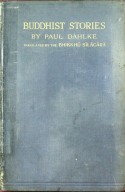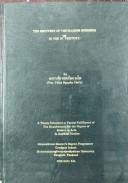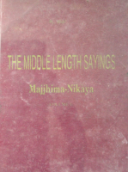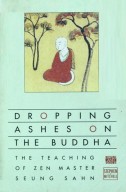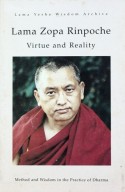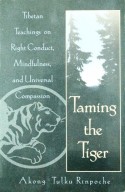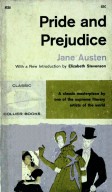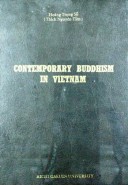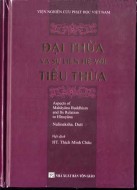Tìm Sách
Sách tiếng Anh-English >> History of Buddhism In India
Thông tin tra cứu
- Tên sách : History of Buddhism In India
- Tác giả : Lama Chimpa Alaka Chattopadhyaya
- Dịch giả : Lama Chimpa Alaka Chattopadhyaya
- Ngôn ngữ : Anh
- Số trang : 472
- Nhà xuất bản : Indian Institute of Advanced Study
- Năm xuất bản : 1970
- Phân loại : Sách tiếng Anh-English
- MCB : 1210000002821
- OPAC :
- Tóm tắt :
Translated from the Tibetan by Lama Chimpa Alaka Chattopadhyaya
Edited by Debiprasad Chattopadhyaya
CONTENTS
Preface
Acknowledgement
On Typography and abbreviations, etc
TARANATHA’S HISTORY OF BUDDHISM IN INDIA
Introductory
Benedictory Verse
Aim of the Work
Table of Contents
The Sources
Ch. 1. – Account of the Period of King Ajatasatru
Ch. 2. – Account of the Period of King Subãhu
Ch. 3. – Account of the Period of King Sudhanu
Ch. 4. – Account of the Period of Ãrya ưpagupta
Ch. 5. – Account of the Period of Ãrya Dhltika
Ch. 6. – Account of the Period of King Asoka
Ch. 7 – Account of the Incidents During the Period of King Asoka
Ch. 8. – Account of the Period of King Vigatasoka
Ch. 9. – Account of the Period of Kãsyapa, the Second
Ch. 10. – Account of the Period of Ãrya Mahãloma and Others
Ch. 11. – Account of the Period of King Mahãpadma
Ch. 12. – Account of the Period of the Third Council
Ch. 13. – Account of the Period of the Beginning of the Extensive Propagation of the Mahãyãna
Ch. 14. – Account of the Period of Brãhmana Rãhula
Ch 15. – Account of the Period of the Doctrine Under the Leadership of Arya Nagarjuna
Ch. 16. – Account of the Period of the First Hostility to the Law and of its Restoration
Ch. 17. – Account of the Period of Acarya Aryadeva and Others
Ch. 18. – Account of the Period of Ãcãrya Matrceta and Others
Ch. 19. – Account of the Period of the Renewed Hostility to the Doctrine and of its Restoration
Ch. 20. – Account of the Period of the Third Hostility to the Doctrine and of its Restoration
Ch. 21. – Account of the Period of the Final Activities of King Buddhapaksa and of the period of King Karmacandra
Ch. 22. – Account of the Period of ‘Brothers Ãrya Asanga [Asanga and Vasubandhu]
Ch. 23. – Account of the Period of Ãcãrya Dignãga and Others
Ch. 24. – Account of the Period of King Sila
Ch. 25. – Account of the Period of the Kings Cala, Pancamasimha and Others
Ch. 26. – Account of the Period of Sri Dharmaklrti
Ch. 27. – Account of the Period of King Govicandra and Others
Ch. 28. – Account of the Period of King Gopãla
Ch 29. – Account of the Period of King Devapãla and His Son
Ch. 30. – Account of the Period of King Sri Dharmapãla
Ch. 31. – Account of the Period of King Masurakslta, King Vanapãla and the Great King Mahĩpãla
Ch. 32. – Account of the Period of the Kings Mahãpãla and Samupala
Ch. 33. – Account of the Period of King Canaka
Ch. 34. – Account of the Period of Kings Bheyapãla and Neyapãla
Ch. 35. – Account of the Period of Ãmrapãla, Hastipãla and Ksãntipãla
Ch. 36. – Account of the Period of King Rãmapãla
Ch. 37. – Account of the Period of the Four Sena Kings and Others
TARANATHA’S SUPPLEMENT TO THE HISTORY OF BUDDHISM IN INDIA
Ch. 38. – Account of the Succession of Teachers at Vikramaslla
Ch. 39. – Account of the Spread of the Doctrine in Ko-ki in the East
Ch. 40. – Account of the Introduction of the Law into the Smaller Islands and of its Revival in the South
Ch. 41. – Account of the Spread of the Doctrine in the South as Related in The Garland of Flowers
Ch. 42. – Some Discussion on the Four Sects
Ch. 43. – A Brief Discourse on the Origin of the Mantrayana
Ch. 44. – The History of Image-makers
On the Sources etc
Epilogue
Colophon
Colophon of the Potala editions
PREFACE
Born in A.D. 1575, Kun-dga’-sfiin-po (=3 Ẵnandagarbha), better known as Lama Tãranãtha, wrote this work in 1608, i.e. at the age of 34, according to the Tibetan mode of calculating the age. This work is usually referred to as rGya-gar-chos-byun, which means “the history of Buddhism in India”. But the brief title Tãranãtha himself chose for it was dGos-dod-kun-byun, literally “that which fulfils all desires”. The corrupt Indian form in which the name occurs in the title-page of its Potala edition (1946), namely Kãrya-kãma-sarva-pravrtti-nãma, is evidently intended to convey the same idea. Thus the history of Buddhism in India was for Tãranãtha something more than mere history. It was also the mãhãtmya of Buddhism: the account was intrinsically auspicious, so much so that it led to the fulfilment of all desires. But there is nothing extraordinary about this. As Vasil’ev (spelt Wassiljew in German) rightly remarks, historiography for the Buddhists had always been an important mode of propagating their creed.
In Tibetan writings Tãranãtha is usually mentioned as “Jo-nan Tãranãtha” or “rje-btsun (S5S bhattaraka) Tãranãtha of the Jo-nan sect”. Jo-nan is the name of a place with a lofty caitya and a convent about a hundred miles to the north-west of the Tashi-lhun-po. The sect of Tibetan Buddhism which had Jo-nan as its stronghold came to be known as the Jo-nan-pa sect. The founder of this sect was Phyogs-las-rnam-rgyal (= Digvijayi), born in A.D. 1306. It appears that a pronounced enthusiasm for the Kãlacakra Tantra constituted an important feature of its creed. Tãranãtha himself, a later leader of the sect, was famous as an author of several works and “guide-books” (khrid-yid) on the Kalacakra doctrine, which Roerich wanted to analyse—a project unfortunately left unfinished by him.
The chief monastery of the Jo-nan-pa sect—rTag-brtan- phun-tshogs-glin (= the perfect and eternally firm island)— had a printing establishment well-known in Tibet. The complete Tãranãtha works of Tãranãtha were published by it. A copy of this is preserved in the Tsybikov Collection, Institute of the Peoples of Asia (now renamed as the Institute of Oriental Studies), USSR. A. I. Vostrikov gives us the following information about Taranatha’s works from this collection.
The present history of Buddhism consisting of 143 folios is contained in the sixteenth volume of Taranatha’s collected works, the same volume also containing in 70 folios the work (written in A.D. 1600) with the brief title bKa’-babs-bdun-ldan, translated into German by A. Griinwedel. The first volume of the collected works contains a detailed autobiography of Tãranãtha in 331 folios, the second volume contains a history of the Kãlacakra system in 22 folios, the tenth volume contains a history of the Yamãntaka Tantra in 74 folios (its colophon giving the date of the composition as A.D. 1631) and the twelfth volume contains a history of the cult of Tãrã in 20 folios. From these one can easily judge how voluminous a writer Tãranãtha was and in what constituted his main interest.
By courtesy of the Institute of the Peoples of Asia, Leningrad, 1 obtained a microfilm copy of the so-called “secret” biography (gsah-ba’i-rnam-thar) of Tãranãtha written by himself: though brief, it is so full of the so-called mystic or occult experience and a quaint vision, that we had to give up our original idea of appending its translation to the present edition. Such mystic stuff is not easy to translate and, if translated at all, would not make much sense for the modern reader. Incidentally, in Northern Mongolia (Urga) the incarnations of Lama Tãranãtha are supposed to have resided even in recent times!
The original printing blocks of Taranatha’s works were largely destroyed “during the persecution of the Jo-nan-pa sect in the time of the Fifth Dalai Lama (ftag-bdan-blo-bzan- rgya-mtsho : A.D. 1617-1682) in the first half of the 17th century A.D. The Karma-pa and the Jo-nan-pa sects supported the ruler of Tsan [i.e. a central province of Tibet of which the chief city is Shiga-tse, adjoining which stands the grand monastery of Tashi-lhun-po, the seat of the Tashi Lama] and thus incurred the enmity of Lhasa and of the dGe-lugs-pa sect [i e. the most dominant sect of Tibetan Buddhism usually referred to by the European authors as the Yellow Cap sect]. In the chief monastery of the (Jo-nan-pa) sect, rTag-brtan- phun-tshogs-glin, were preserved the printing blocks of the works of Tãranãtha. Many of the printing blocks were destroyed and the monastery itself was renamed [as dGa’-ldan- phun-tshogs-glin].”
Apparently, over two centuries later the Lhasa rulers realised that at least Taranatha’s history of Buddhism in India was too precious to be allowed to remain out of circulation. Hence in 1946 a fresh edition of the work was prepared in Potala in 141 folios. The present translation follows mainly this edition, though it also takes note of the first letter-press edition of the Tibetan text published from St. Petersburg in 1868 as edited by A. Schiefner. There exists another letter- press edition of the work published from Varanasi in 1963 as edited by Chos-rje-bla-ma. This edition, however, appears to have been intended as a literal reproduction of the Potala edition of 1946.
Taranatha’s History is surely one of the most widely discussed works in contemporary Indology. The modern scholars owe their information of it mainly to A. Schlefner and V. P. Vasil’ev. Their German and Russian translations of the work appeared from St. Petersburg in 1869. As to their mutual relation and the circumstances that led them to take up these translations, it is best to follow their own statements. These are to be found appended to the present work. Readers are moreover likely to find the introduction of Vasil’ev to Tãranãtha’s History illuminating in many respects.
Schiefner’s German and Vasil’ev’s Russian apart, the only complete translation of Taranatha’s History exists in the Japanese language: the translation was done by Enga Tera-moto, it contains 404 pages and was published from Tokyo in 1928 by Heigo Shuppan-sha. From a stray reference it appears that the great Indian linguist Harinath De started translating Taranatha’s History directly from Tibetan into English and that at least some pages of this translation appeared in a journal called The Herald, January 1911. Any copy of this journal is hard to trace and it appears that this was one of the • innumerable projects left unfinished by the great linguist. Only the other day, we received the heartening news that a few pages of this translation (? all that the great linguist translated) have been recovered and that these are going to be reprinted in the forthcoming issue of the Journal of Ancient Indian History, Calcutta University.
While preparing the present translation, our main purpose has been to make the work as intelligible as we could for the modem reader. This means much more than the ‘task of transferring a text from one language into another. Taranatha’s statements could be made more intelligible only by annotating these extensively, and this mainly by way of collecting other materials that have some light to throw on his statements. The limitation of the annotations given by us is obvious and none can perhaps be more keenly aware of it than we are. We have dared to present this translation in spite of the obvious inadequacy of the annotations mainly with the hope of attracting the attention of the really great scholars from whom are expected profound comments. These alone would make the text more intelligible. As for our own annotations, we are anxious to be clear about a few points.
First, we have attempted to incorporate into our annotations practically all the important annotations of Vasil’ev and Schiefner. Though a hundred years old, these annotations contain much more than mere historic interest. These have often vital relevance for understanding Tãranãtha properly. Secondly, we have, in our annotations, mentioned practically all the major points on which the present translation differs from those of Vasilev and Schiefner. Though fully aware of the rather severe comments of eminent Tibetologists like A.I. Vostrikov and E.E. Obermiller on the accuracy of tjie translations of both Vasifev and Schiefner, we are also aware that these translations substantially helped the later compilers of the standard Tibetan dictionaries like Jaschke and Das. Therefore, the purpose of pointing out where the present translation differs from that of Vasil’ev or Schiefner is not necessarily to claim greater accuracy in favour of the present translation. On the contrary, our own experience is that Taranatha’s Tibetan is often hard to understand and it is sometimes difficult to be sure of the exact sense he wants to convey, particularly because of some peculiar ambiguities of the classical Tibetan language. While presenting the present translation, the possibility of an alternative understanding of some of the passages is taken into consideration and it has been but our simple duty to mention such alternatives as actually suggested by the great pioneers. Thirdly, our annotations have sometimes assumed the form of long quotations from the writings of eminent modern scholars. The reason for quoting them at such length has simply been the anxiety. to allow them to speak in their own language, so that the risk of misrepresenting their point could be eliminated.
It is not for us to answer the question how Tãranãtha’s account of Buddhism, in spite of being so overwhelmingly legendary, could also become one of the most widely discussed texts for the modern scholars working on diverse aspects of ancient and medieval Indian history and culture. Writers on the political history of India find themselves obliged to take note of Tãranãtha’s History, no less than those writing the history of Indian literature and Indian logic, not to speak of the investigators of the history of Buddhism itself. Apparently, along with all sorts of quaint stories, Tãranãtha somehow or other managed to squeeze into this brief work a tremendous amount of solid historical data (and interesting Indian folklore) which are not easy to trace in other available sources. The very attempt to reconstruct a connected account from the time of Ajãtaáatru to that of the Turuska invasion—in the background of which Tãranãtha wants us to understand the history of Buddhism in India—appears to us to be an amazing intellectual performance, particularly when we remember that it was done in A.D. 1608 by a Tibetan scholar in his early thirties. Of course, as Vasil’ev rightly remarks, it is not to be taken as a finished history, but rather as a draft demanding a great deal of further investigation and that the importance of the work lies more particularly in its chapters covering the period intervening between the visit of Yuan-chuang and the virtual extinction’of Buddhism in India.
Of the varied suggestions given by Tãranãtha regarding this period, we may mention here only one. He left for us, though in his own way, clear indications of the factors that contributed to the decline and fall of Buddhism in India. Buddhism in its latest phase, as Tãranãtha so vividly described it, almost completely surrendered precisely to those beliefs and practices, as a direct rejection of which the Buddha himself had preached his original creed. For all we know, it was a creed concerned above all with the fact of suffering and with the way out of suffering. As Stcherbatsky puts it, “It can hardly be said to represent a religion. Its more religious side, the teaching of a path, is utterly human. Man reaches salvation by his own efforts, through moral and intellectual perfection. Nor was there, for aught we know, very much of a worship in the Buddhism of that time. The community consisted of recluses possessing neither family nor property, assembling twice a month for open confession of their sins and engaged in the practice of austerity, meditation and philosophic discussions. The Buddha preached all these precisely because he had realised the futility of worshipping God or a host of demi-gods, offering sacrifices to them or trying to coerce them with magical rituals. For the Buddha himself, these beliefs and practices were characteristics of the tirthika-s or outsiders. By contrast, Buddhism in its latest phase—if we are to trust Tãranãtha—bowed down to all these beliefs and practices and thus became practically indistinguishable from popular Hinduism so-called. It assumed the form of being an elaborate worship of all sorts of gods and goddesses of the popular pantheon—often under new names, but sometimes caring not even to invent any new name for them—and of indulging in all sorts of ritual practices for which the Buddha himself had expressed his unambiguous repulsion. Thus, e.g., the Vikramasĩla-vihãra, the last grand centre of Buddhism established in India, had even the provision for a Bali-ãcãrya and a Homa-ãcãrya! Buddhajnanapada, Tãranãtha further tells us, persuaded king Dharmapãla to perform a homa for many years, during which period the king spent over nine lakh and two thousand tolas of silver—and all these were designed to make his dynasty last longer! And so on. Evidently, the memory of the human founder of the creed and even the vestige of his essentially human teachings were fully lost to the Buddhists and their patrons when Buddhism assumed such a queer form. The ideology, in short, passed into its opposite, and being left with no internal justification to survive as a distinct creed, the only thing on which it could then thrive was the fad of some big patron, the Pãlas being about the last of them. With the withdrawal or collapse of this patronage, Buddhism as a religion had to go into pieces.
Sharing fully the creed in its latest phase, Tãranãtha is of course not expected to have realised all these. As far as he understood, therefore, the end of the Vikramaslla and the Odantapurĩ meant the end of Buddhism in India: with the fall of these two monasteries the Buddhist ãcãrya-s ran hither and thither, seeking shelter in Kashmir, Nepal and the Ko-ki countries. He does not ask himself how can a creed, so long as it possesses any inner vitality, become virtually extinct from such a vast country only with the fall of two centres situated somewhere in Bihar…
May 26, 1970. Debiprasad Chattopadhyaya
 Facebook
Facebook
 Google
Google
 Google+
Google+


